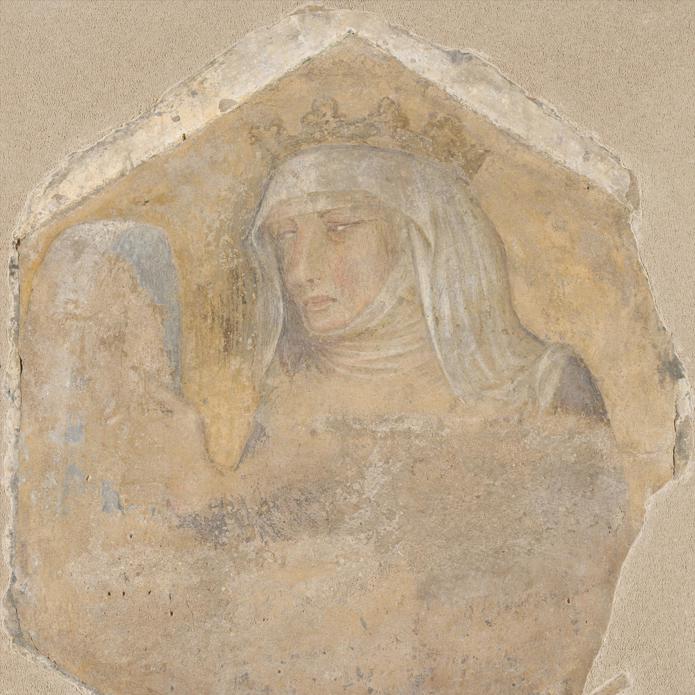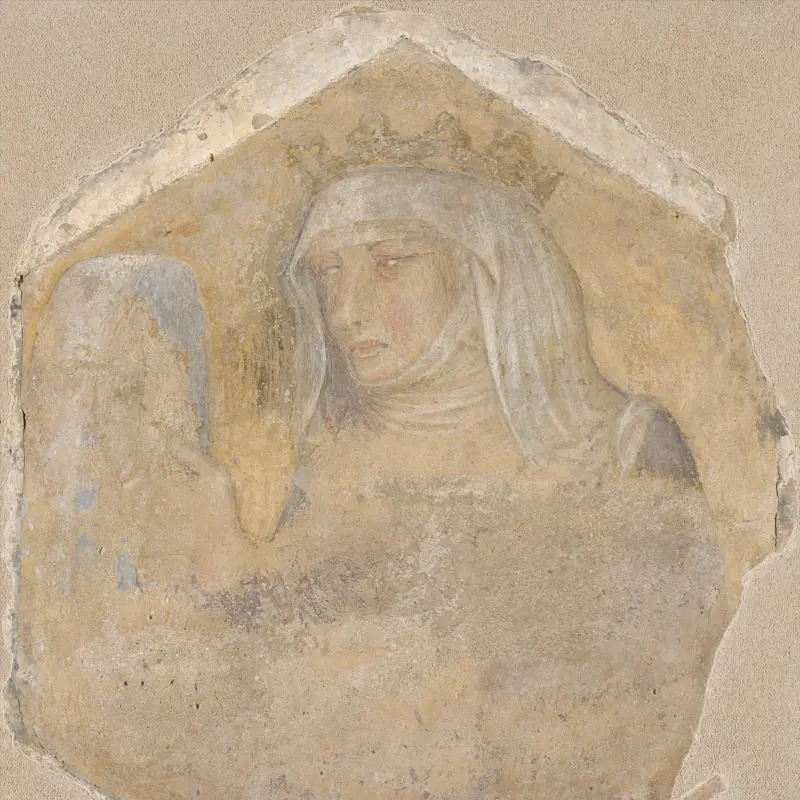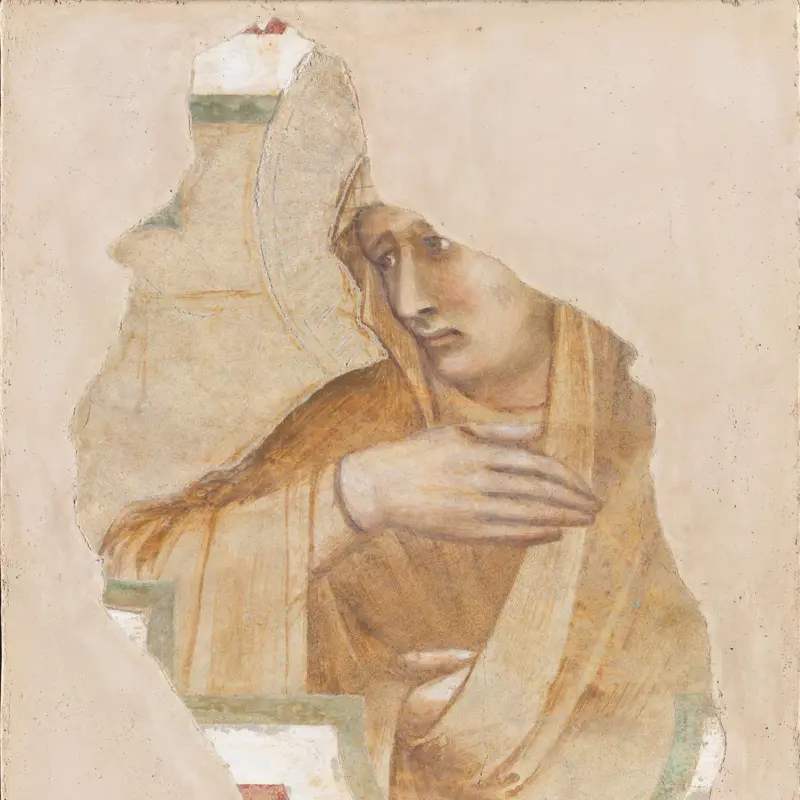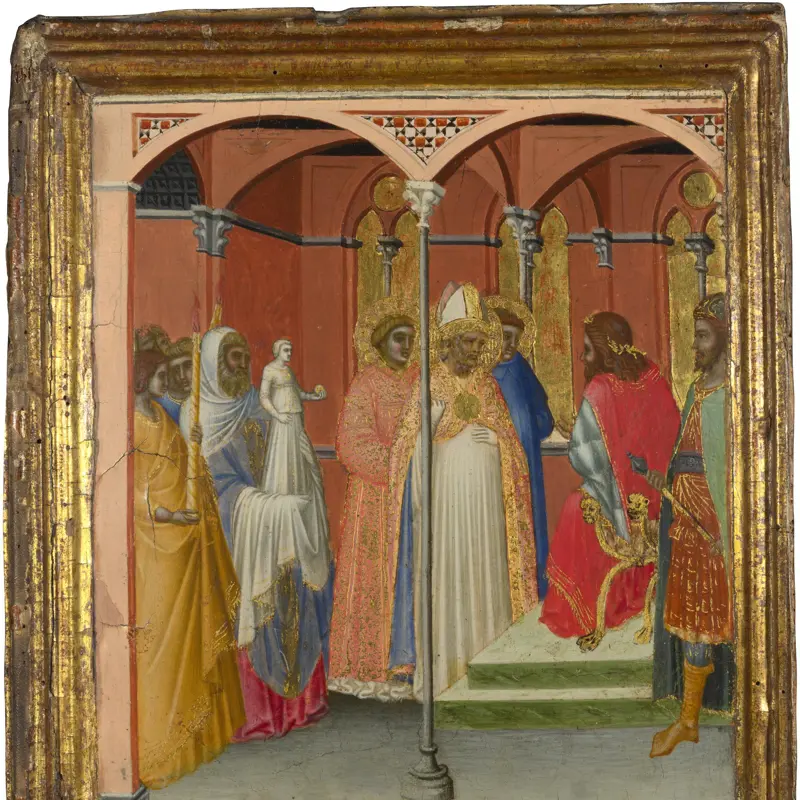Pietro Lorenzetti and Workshop, 'A Crowned Female Figure (Saint Elizabeth of Hungary?)', 1320s
About the work
Overview
The crown and the millstone, faintly visible at her right side, suggest the woman may be Saint Elizabeth of Hungary, who according to legend, after her death cured the hand of man after it was crushed by a millstone. Though royal, she joined a Franciscan lay order and took a vow of poverty, dedicating her life to charity.
This fragment of fresco once formed part of the border decoration of a large wall painting in the chapter house of San Francesco, Siena. It was removed in the nineteenth century and purchased by the archaeologist and National Gallery trustee, Austen Henry Layard. As an example of the work of the workshop of the Sienese painter Pietro Lorenzetti, who, with his brother decorated important public and religious buildings in Siena with frescoes, it was a desirable object despite its poor condition. Layard was a member of the Arundel Society founded to document and preserve Italian frescoes.
Key facts
Details
- Full title
- A Crowned Female Figure (Saint Elizabeth of Hungary?)
- Artist
- Pietro Lorenzetti and Workshop
- Artist dates
- Active possibly 1306, died probably 1348
- Part of the series
- Pietro Lorenzetti Fresco Fragments
- Date made
- 1320s
- Medium and support
- Fresco with areas of secco
- Dimensions
- 38 × 33 cm
- Acquisition credit
- Layard Bequest, 1916
- Inventory number
- NG3071
- Location
- Not on display
- Collection
- Main Collection
- Previous owners
Provenance
Additional information
Text extracted from the ‘Provenance’ section of the catalogue entry in Dillian Gordon, ‘National Gallery Catalogues: The Italian Paintings before 1400’, London 2011; for further information, see the full catalogue entry.
Bibliography
-
1864J.A. Crowe and G.B. Cavalcaselle, A New History of Painting in Italy: From the Second to the Sixteenth Century, 3 vols, London 1864
-
1951Davies, Martin, National Gallery Catalogues: The Earlier Italian Schools, London 1951
-
1978M. Seidel, 'Wiedergefundene Fragmente eines Hauptwerks bon Ambrogio Lorenzetti: Ergebnisse der Restaurierungen im Kloster von S. Francesco in Siena', Pantheon, XXXVI, 1978, pp. 119-27
-
1979M. Seidel, 'Gli affreschi di Ambrogio Lorenzetti nel Chiostro di S. Francesco a Siena: Riconstruzione e datazione', Prospettiva, XVIII, 1979, pp. 10-20
-
1986Davies, Martin, National Gallery Catalogues: The Earlier Italian Schools, revised edn, London 1986
-
1986M. Boskovits, 'Considerations on Pietro and Ambrogio Lorenzetti', Paragone, CDXXXIX, 1986, pp. 3-16
-
1988Gordon, Dillian, National Gallery Catalogues: The Early Italian Schools before 1400, revised edn, London 1988
-
1989C. Volpe, Pietro Lorenzetti, Milan 1989
-
2001
C. Baker and T. Henry, The National Gallery: Complete Illustrated Catalogue, London 2001
-
2011Gordon, Dillian, National Gallery Catalogues: The Italian Paintings before 1400, London 2011
-
2024J. Cannon, C. Campbell and S. Wolohojian (eds), Siena: The Rise of Painting 1300-1350 (exh. cat. Metropolitan Museum of Art; National Gallery, London), London 2024
About this record
If you know more about this work or have spotted an error, please contact us. Please note that exhibition histories are listed from 2009 onwards. Bibliographies may not be complete; more comprehensive information is available in the National Gallery Library.
Images
About the series: Pietro Lorenzetti Fresco Fragments

Overview
These two fragments of frescoes (which were painted directly onto a freshly plastered wall) come from the Sienese convent church of San Francesco. They were part of the border decoration of larger fresco paintings on the walls of the church’s chapter house. By the time they were discovered in the mid-nineteenth century, the chapter house had been converted into a blacksmith’s workshop and the frescoes had been covered with whitewash.
Once restored, the larger surviving frescoes were moved to chapels in the church itself. These fragments appear almost monochrome as their removal from the wall damaged the coloured surface painting, revealing the brownish preparatory design below.



